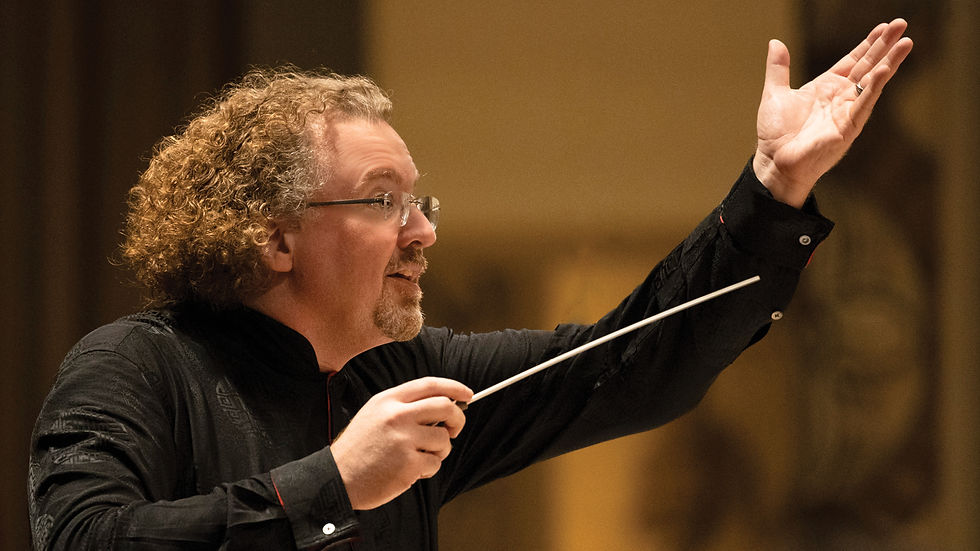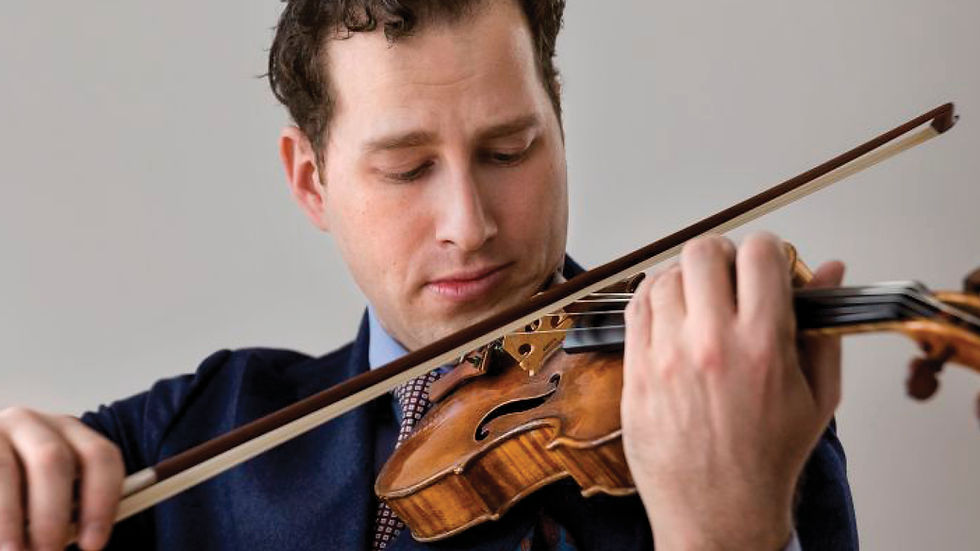Program Notes: Beethoven's Fifth Symphony (November 13-14, 2021)
- SLSO
- Nov 8, 2021
- 5 min read
Program
Stéphane Denève, conductor
Víkingur Ólafsson, piano
Carlos Simon
Fate Now Conquers (2020)
Edvard Grieg
Piano Concerto in A minor, op. 16 (1868)
Allegro molto moderato
Adagio—
Allegro moderato molto e marcato
Víkingur Ólafsson, piano
Ludwig van Beethoven
Symphony No. 5 in C minor, op. 67 (1807)
Allegro con brio
Andante con moto
Allegro—
Allegro
Program Notes
By Tim Munro
Stéphane on this program
When I think about Ludwig van Beethoven’s Fifth Symphony, the word I think of is freedom. Beethoven was very influenced by the ideals of the French Revolution. Indeed, Beethoven seriously considered moving to France.
The Fifth is an experimental symphony. The opening is strange, with no clear harmony for a long time. There is this ambiguity: what key are we in?
The third movement is most fascinating. It opens with this melody that is later transformed into something so strange, becoming almost pointillistic. Then there is this long low note that seems to go on forever.
The finale introduces new instruments to the orchestra. It is the first symphony to use trombones, and the first with a dedicated contrabassoon part. The music is daring and rough, even brutal.
I would love for our performance to find something fresh and new in Beethoven's music. People know this symphony so well, but I would love for us to make this symphony as weird as it would have sounded in Beethoven’s life.
Beethoven’s music has energy that is bigger than life. Carlos Simon’s Fate Now Conquers captures this raw energy, without ever clearly quoting Beethoven. It is very much Simon’s musical voice, speaking in a modern way.
I have a touching story about Edvard Grieg’s Piano Concerto. When I graduated from the Conservatoire with the Gold Medal, the director proposed that I play a concerto. I chose the Grieg concerto.
My teacher at the time, André Dumortier, studied the Grieg Concerto with Arthur de Graaf, who was a friend of Grieg's and played in the first Belgian performance of the concerto. I worked on this piece with a teacher who was one handshake from Grieg.

Fate Now Conquers
Carlos Simon
Born 1986, Washington, D.C.
Near the end of the Iliad, the warrior Hector dies at the hands of Achilles. With his last breaths, Hector says, “Fate now conquers; I am hers; and yet not she shall share in my renown; that life is left to every noble spirit and that some great deed shall beget that all lives shall inherit.”
When composer Carlos Simon was asked to write a musical response to Ludwig van Beethoven’s symphonies, he turned to this quotation from the Iliad, which Beethoven had jotted in a journal. “Beethoven strived to overcome many obstacles,” says Simon. “In the end, it seems that he relinquished himself to fate.”
Simon’s music background is rich and varied. Growing up in the church, he lived and breathed gospel music. In his twenties, he was music director for both an R&B vocalist and a Broadway star. Now primarily a composer, he writes for the concert hall, film, “and anything else that affords me an opportunity to use my gift.”
Strings tremble and orchestral lightning strikes again and again. The music of Fate Now Conquers, writes Simon, is “representative of the unpredictable ways of fate. There are jolting stabs, an agitated groove, and frenzied arpeggios in the strings.”
Simon strived to pay homage to Beethoven while remaining true to his own artistic voice. He found himself able to “release my expectations and hope for the best.” In other words, to relinquish himself to fate.
First performance: October 8, 2020, by the Philadelphia Orchestra, Yannick Nézet-Séguin conducting
First SLSO performance: This weekend’s concerts
Instrumentation: flute, piccolo, 2 oboes, 2 clarinets, 2 bassoons, 2 horns, 2 trumpets, timpani, strings
Approximate duration: 5 minutes

Piano Concerto
Edvard Grieg
Born June 15, 1843, Bergen, Norway
Died September 4, 1907, Bergen, Norway
Edvard Grieg’s Piano Concerto was an instant hit. Performances sprang up across the globe, bringing the young man to renown. Because of a prior engagement, Grieg was not present for the concerto’s auspicious premiere. The following imagines a letter a friend might have written to Grieg. The friend is fictional, but all details about Grieg’s life are factual.
April 4, 1869
Kjære Edvard,
We were saddened that you were not able to attend the first performance of your Piano Concerto last night in Copenhagen. So we decided to write with our impressions of the event.
The opening came as a bolt from the blue! I could imagine the great Robert Schumann, whose music I know you admire, bowled over. After your unhappy years spent in Germany—stuffy teachers, awful illnesses—his spirit still runs through your music.
Norway is everywhere present in your concerto. Your music has long soaked up the songs, sagas, history, and landscape of Norway, and this concerto sings with the unpretentious spirit of our beautiful homeland.
Norway these days is considered something of a backwater. Sometimes it seems like every Norwegian artist lives abroad! Imagine our delight that you and your wife have committed to stay and build the foundations of an artistic community here.
Speaking of your wife, we have so many wonderful memories of Nina singing with you at the piano. Is it her singing that gives the inspiration for the soaring vocal melodies in this concerto?
We also noticed the presence of a halling dance tune in the last movement. We love to watch this old dance performed at weddings—complete with spins and kicks!—and wonder if it was a not-so-secret love letter to your own bride?
The work received a huge ovation. After the concert there were so many whispers of future performances.
Also, congratulations on the birth of your daughter. There is a strong, beating heart in this concerto. We wonder if it is little Alexandra’s...
Med vennlig hilsen.
First performance: April 3, 1869, by the Royal Danish Orchestra, in Copenhagen, Holger Simon Paulli conducting, with Edmund Neupert as soloist
First SLSO performance: January 30, 1908, Max Zach conducting, with Katharine Goodson as soloist
Most recent SLSO performance: September 23, 2018, Gemma New conducting, with Behzod Abduraimov as soloist
Instrumentation: solo piano, 2 flutes (2nd doubling piccolo), 2 oboes, 2 clarinets, 2 bassoons, 4 horns, 2 trumpets, timpani, strings
Approximate duration: 30 minutes

Symphony No. 5
Ludwig van Beethoven
Born December 16, 1770, Bonn, Germany
Died March 26, 1827, Vienna, Austria
Ludwig van Beethoven was 18 when the French Revolution erupted. The young man, who loved liberty “above all things” and sported rebellious sideburns, cheered as the Bastille fell.
Beethoven poured revolutionary fervor into music. His first two symphonies were inspired by revolutionary hymns and symphonies sweeping Europe. The third was a portrait of Napoleon, its boldness challenging both players and listeners.
The Fifth Symphony builds on these foundations. The opening scurries with anxiety, hinting at a hymn by his contemporary, Luigi Cherubini, with the text, “We swear, sword in hand, to die for the Republic and for the rights of man.” Beethoven’s music leaves us breathless.
The second movement’s elegant tune floats on air, flows like a stream, holds hands in prayer. Yet martial sounds remain close by. The third movement provides no balm, horns braying, cellos and basses protesting.
In the finale, French military instruments—contrabassoon, trombone, and piccolo—are recruited. A four-note motto finds its feet. The motto is remarkably similar to cries of “La Liberté” from a revolutionary hymn that Beethoven certainly knew.
As Beethoven aged, revolutionary ideals failed, republics rose and fell, leaders abused power. But he remained committed to the cause of liberty, and believed that his music had moral value. That it could make change.
First performance: December 22, 1808, in Vienna, the composer conducting
First SLSO performance: December 5, 1907, Max Zach conducting
Most recent SLSO performance: October 29, 2017, David Robertson conducting
Instrumentation: 2 flutes, piccolo, 2 oboes, 2 clarinets, 2 bassoons, contrabassoon, 2 horns, 2 trumpets, 3 trombones, timpani, strings
Approximate duration: 31 minutes
Tim Munro is the St. Louis Symphony Orchestra’s Creative Partner. A writer, broadcaster, and Grammy-winning flutist, he lives in Chicago with his wife, son, and badly behaved orange cat.
Program Notes are sponsored by Washington University Physicians.




Comments